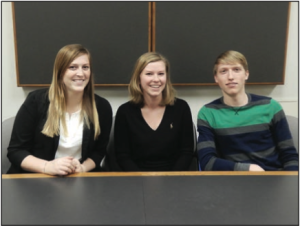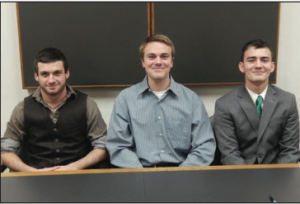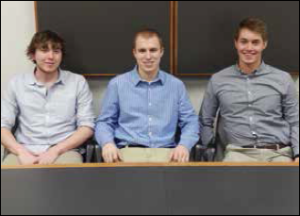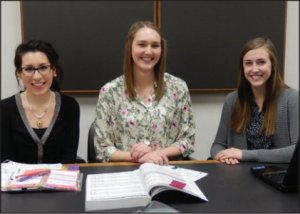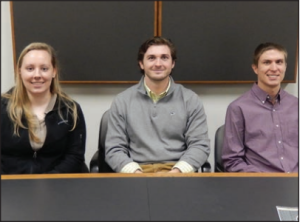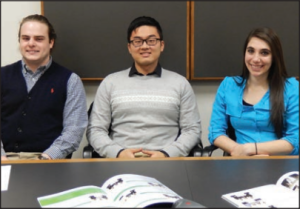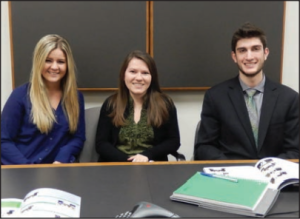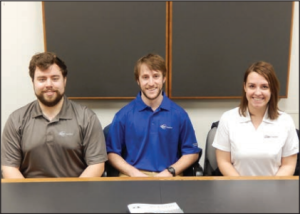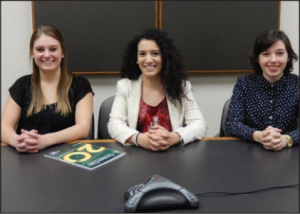Biosystems Engineering student teams, enrolled in the two-semester biosystems design capstone experience, BE 485/487, develop, evaluate, and select design alternatives in order to solve real-world problems. Projects are diverse, but each reflects systems thinking by integrating interconnected issues affecting the problem, including critical biological constraints. The engineering design process is documented in a detailed technical report. Teams present project designs to engineering faculty and a review panel of professional engineers for evaluation. Each BE 485/487 capstone design team prepares and presents a design solution in report, poster and oral formats to an industry advisory board, faculty, peers and the public that:
- Requires engineering design
- Uses a holistic approach
- Combines biology and engineering
- Interprets data
- Solves a real problem
- Evaluates economic feasibility
For information on sponsoring a project, please contact Dr. Dana Kirk or Dr. Luke Reese.
Due to the nature of the two-semester Biosystems & Agricultural Engineering class, projects are not complete until the end of the Spring Semester. The following projects were presented at the Spring 2015 Design Day:
Integrating Water and Energy Engineering with Ecotourism in a Costa Rican Aboriginal Community
Team “Shuabb Systems” has designed an integrated system to provide potable water, wastewater treatment, and energy production for an ecotourism project led by the Shuabb Aborigine Women Association in Costa Rica. By integrating green technologies such as water filters, anaerobic digestion and constructed treatment wetlands, the project aims to secure clean water for human consumption and treat solid waste and wastewater, while creating renewable energy on site. The project is in cooperation with the Gender Equity Office from the Technological Institute of Costa Rica, and can demonstrate the economic value of such development in a region with limited access to public services.
Sponsor – EPA
Faculty Advisor – Dr. Dawn Reinhold
Industry Evaluators – Mr. Larry Stephens, PE & Mr. Rick Woodford, PE
Optimizing Wastewater Irrigation for Food Industry Application
The purpose of this project is to identify and address problems encountered in the center pivot irrigation wastewater treatment process of a food production company. This project uniquely combines aspects of the mechanical, chemical, and biological areas as it looks at refining a process as a whole, rather than just a specific point in the process. It is through providing solutions to the identified problems that the team will deliver supported recommendations to better optimize the current process and improve adherence to standards set forth by the appropriate government agencies.
Sponsor – Major Food Manufacturer
Faculty Advisors – Dr. Steve Safferman, PE & Mr. Steve Miller, PE
Industry Evaluators – Ms. Lisa Buchholz, Mr. Nick Tipper & Mr. Keith Tinsey
Green Infrastructure Design Project
Project sponsor Tetra Tech is working to reduce stormwater runoff in Detroit in order to mitigate sewer system overflow. Team “Flood Control” is working on a Low Impact Development design to capture and treat runoff at Edison Elementary School. Best management practices (BMPs) will be introduced to control and limit the flow rate of stormwater runoff entering the sewer system. Stormwater runoff reduction will decrease the amount of raw sewage disposal into local water bodies and have added environmental benefits. Project deliverables include hydrological models proving that BMPs meet project objectives, CAD drawings of BMPs, and a detailed cost analysis of the final design.
Sponsor – Tetra Tech
Faculty Advisor – Dr. Pouyan Nejadhashemi
Industry Evaluators – Mr. Andrew Granskog, PE & Ms. Ashley Julien
Anaerobic Digestion: A Pre-feasibility Study
Granger is a waste hauling and landfill gas collection company operating throughout the nation. Granger is interested in increasing power production at its Grand River site, and they believe anaerobic digestion could be a potential solution to generate
an additional 600kWh. The “Power Grangers” team is conducting a pre-feasibility study of an anaerobic digester to determine whether it can be implemented into
their current system. This study includes the formulation of a feedstock blend for optimal methane production, an anaerobic digester design, a recommended use for the digestate, operational and regulatory challenges, and a complete economic analysis of the overall system.
Sponsor – Granger
Faculty Advisor – Dr. Dana Kirk, PE
Industry Evaluators – Mr. Bryce Feighner, PE & Mr. Tim Krause, PE
Wastewater Treatment Electrocoagulation
Team “Meat the Spartans” is working with Bellingar packing, a small-scale meat processing facility in St. Johns, Michigan. The team’s objective is to design and construct a system to scale-up to treat 9,000-12,000
gallons of wastewater weekly and comply with MDEQ and EPA discharge standards while producing renewable energy and solid waste fertilizer. The treatment system consists of an anaerobic digester to initiate breakdown of the solids within the wastewater and generate biogas, used to offset natural gas consumed for heating water, followed by an electrocoagulation reactor, which charges solid particles to adhere to one another for easy removal as a concentrated fertilizer.
Sponsor – Bellingar Packing
Faculty Advisor – Dr. Wei Liao, PE
Industry Evaluators – Ms. Michelle Crook, PE & Mr. Mitch Miller
Torrefaction of Biomass
Greenhouse gas emission regulations are increasing, thus creating demand for practical energy alternatives. An alternative being studied is torrefied woody biomass pucks that can act as “drop ins” for coal plants. The puck hydrophobicity is the focus of the project. In order to achieve hydrophobicity comparable to coal, different alternatives will be analyzed including hydrophobic coating applications, altering the process conditions andabindingagent. A break-even analysis will be conducted in order to determine the necessary cost of a carbon dioxide tax on coal in order for the biomass pucks to be competitive.
Sponsor – Heat Transfer International (HTI)
Faculty Advisor – Dr. Chris Saffron
Industry Evaluators – Mr. Bob Ellerhorst, PE & Mr. Dave Prouty
Utilization of Chitosan as a Bio-pesticide Extracted from Sugar Beet Pulp
Michigan Sugar produces 25,000 tons of sugar beet pulp per year which is predominately used as a low value animal feed. Due to the increasing competitiveness of sugar beet processing, it is critical to develop a more valuable byproduct. Team “Sugar BE-ets’ ” project goal is to utilize wet sugar beet pulp by applying the biological method of simultaneous saccharification and fungal fermentation to produce chitosan for use as a bio-pesticide.
Sponsor – Michigan Sugar Company
Faculty Advisor – Dr. Yan (Susie) Liu
Industry Evaluators – Mr. Gene Ford, Ms. Danielle Habitz & Dr. Jeff Mathews
Reducing Spoilage Microorganisms in Cherry Pomace
Team “Microbe Busters” is to create a design to reduce the amount of spoilage microorganisms in cherry pomace, a by-product of tart cherry juicing, without degrading positive phytochemical attributes of the pomace.
Client deliverables include a design with optimized operation parameters, testing that demonstrates the design solution’s effectiveness, a vendor recommendation, and an economic analysis of operation and capital costs associated with the design.
Industry Evaluators – Mr. Steve Richey, Mr. Steve Mohr & Mr. Muluken Tilahun
JBT FoodTech Continuous Freezer Conveyor Belt Cleaning System
The “Clean Freeze” team project is to design a continuous, run cold, external belt rinser and drier for a JBT GC M10 Tight Curve spiral freezer. After frozen food product exits the freezer, the system will clean the belt of built-up frost and food debris with an optional allergen abatement method and then completely dry the belt before food is placed on it.
Client deliverables for this project include a mathematical model of the design, a tested prototype design, a full-scale design recommendation, a complete bill of materials, and an economic feasibility analysis.
Sponsor – JBT FoodTech
Faculty Advisors – Dr. Sanghyup Jeong & Mr. Phil Hill
Industry Evaluators – Ms. Cassaundra Edwards & Mr. Andrew Knowles
Wearable Phototherapy Device for Jaundice Treatment
Jaundice, or hyperbilirubinemia, is a medical condition that affects approximately 60% of newborns. It is caused by an excessive formation of the product of red blood cell breakdown (bilirubin) in the blood. Current treatments include blue light phototherapy administered in an incubator. This treatment method is expensive and disrupts critical mother and infant bonding time.
A design is proposed for a safe and wearable phototherapy treatment device that prevents the separation of mother and infant. The device is intended to be a portable and affordable treatment method for developing countries where jaundice is prevalent and power sources are limited.
Sponsor – Biosystems and Agricultural Engineering
Faculty Advisors – Dr. Tim Whitehead & Mr. Steve Marquie
Industry Evaluators – Mr. Ralph Elias & Mr. Steve Steffes, PE

